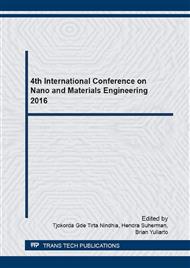p.143
p.149
p.154
p.159
p.163
p.169
p.175
p.180
p.189
Simulation Model of Multiple Cluster Fractals Cultured in Nanocomposite Polymer Electrolyte Film
Abstract:
This work contributes to the melioration of the modeling and simulation of laboratory cultured fractals using poly (vinylidene fluoride-co-hexafluoropropylene)/poly (ethyl methacrylate)-ammonium trifluorome-thanesulfonate nanocomposite polymer electrolyte films as the media of growth. Main focus is given to fractals and fractal growth models particularly DLA (Diffusion Limited Aggregation). The DLA cluster formed through DLA is formed by particles moving in Brownian motion (diffusion) which meet and stick together randomly (aggregation) to form the cluster. The simulation of multiple cluster fractals is done using DLA methods incorporating different parameters such as its sticking coefficient, lattice geometry and number of particles. To compare the simulation with the real patterns obtained, one vital aspect would be the calculation of their fractal dimension values. The computer program developed is able to calculate the fractal dimension value of each of the simulated fractal patterns. Suitable fractal dimension calculation method is employed according to its usefulness and efficiency. Fractal growth modeling and simulation such as done here can contribute to the understanding of other related studies concerning fractal growth found in areas including medical (nervous systems, cancer growth and more).
Info:
Periodical:
Pages:
163-168
Citation:
Online since:
August 2016
Keywords:
Price:
Сopyright:
© 2016 Trans Tech Publications Ltd. All Rights Reserved
Share:
Citation:


